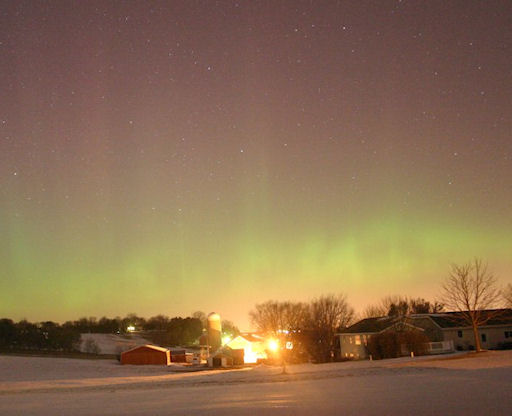AURORAS INVADE THE USA: Earth's magnetic field is still reverberating from a CME strike on March 10th. During the past 24 hours, Northern Lights have descended as far south as Wisconsin, Minnesota, and Michigan in the United States. "It was nice to see the aurora borealis again after so many years of low activity," says Jerry Zhu, who sends this picture from Madison, WI:
Solar wind conditions favor more geomagnetic storming in the hours ahead. Sky watchers--even those in the continental United States--should remain alert forauroras.
more USA images: from Shawn Malone of Marquette, Michigan; from Andrew Krueger of Duluth, Minnesota; from Dennis Zerwas Jr near Cambridge, Minnesota;from Bill Doms of Santiago, Minnesota; from Bob Conzemius of Grand Rapids, Minnesota; from Kristine Deppe near Cook, Minnesota; from Scott Anttila of Ishpeming, Michigan; from Dan Miller near Duluth, Minnesota;.
Solar wind conditions favor more geomagnetic storming in the hours ahead. Sky watchers--even those in the continental United States--should remain alert forauroras.
more USA images: from Shawn Malone of Marquette, Michigan; from Andrew Krueger of Duluth, Minnesota; from Dennis Zerwas Jr near Cambridge, Minnesota;from Bill Doms of Santiago, Minnesota; from Bob Conzemius of Grand Rapids, Minnesota; from Kristine Deppe near Cook, Minnesota; from Scott Anttila of Ishpeming, Michigan; from Dan Miller near Duluth, Minnesota;.
UPDATED: March 2011 Aurora Photo Gallery
[previous Marches: 2010, 2009, 2008, 2007, 2006, 2005, 2004, 2003, 2002]
X-FLARE: March 9th ended with a powerful solar flare. Earth-orbiting satellites detected an X1.5-class explosion from behemoth sunspot 1166 around 2323 UT. A movie from NASA's Solar Dynamics Observatory shows a bright flash of UV radiation plus some material being hurled away from the blast site:[previous Marches: 2010, 2009, 2008, 2007, 2006, 2005, 2004, 2003, 2002]
UPDATE (March 10 @ 1800 UT): Newly-arriving coronagraph data from the Solar and Heliospheric Observatory show no bright CME emerging from this eruption. Some material was surely hurled in our direction, but probably not enough for significant Earth-effects.
After four years without any X-flares, the sun has produced two of the powerful blasts in less than one month: Feb. 15th and March 9th. This continues the recent trend of increasing solar activity, and shows that Solar Cycle 24 is heating up. NOAA forecasters estimate a 5% chance of more X-flares during the next 24 hours.
SOLAR FLARE ALERTS: Would you like a call when the next X-flare erupts? Sign up for Spaceweather PHONE.
| Near Earth Asteroids |
On March 11, 2011 there were 1204 potentially hazardous asteroids.
Recent & Upcoming Earth-asteroid encounters:
| Asteroid | Date(UT) | Miss Distance | Mag. | Size |
| 2011 EC | Mar 6 | 9.2 LD | -- | 34 m |
| 2011 EO11 | Mar 6 | 1.8 LD | -- | 15 m |
| 2011 EY11 | Mar 7 | 0.3 LD | -- | 9 m |
| 2011 EM40 | Mar 7 | 0.7 LD | -- | 12 m |
| 2011 EL40 | Mar 8 | 3.4 LD | -- | 23 m |
| 2011 EC12 | Mar 8 | 3.3 LD | -- | 30 m |
| 2000 PN9 | Mar 10 | 45.5 LD | -- | 2.6 km |
| 2011 EU20 | Mar 11 | 1.6 LD | -- | 16 m |
| 2011 BE38 | Apr 10 | 48 LD | -- | 1.0 km |
| 2002 DB4 | Apr 15 | 62.5 LD | -- | 2.2 km |
| 2008 UC202 | Apr 27 | 8.9 LD | -- | 10 m |
| 2009 UK20 | May 2 | 8.6 LD | -- | 23 m |
| 2008 FU6 | May 5 | 75.5 LD | -- | 1.2 km |
| 2003 YT1 | May 5 | 65.3 LD | -- | 2.5 km |
| 2002 JC | Jun 1 | 57.5 LD | -- | 1.6 km |
| 2009 BD | Jun 2 | 0.9 LD | -- | 9 m |
| 2002 JB9 | Jun 11 | 71.5 LD | -- | 3.2 km |
| 2001 VH75 | Jun 12 | 42.2 LD | -- | 1.1 km |
| 2004 LO2 | Jun 15 | 9.9 LD | -- | 48 m |
| Essential web links |
| NOAA Space Weather Prediction Center |
| The official U.S. government space weather bureau |
| Atmospheric Optics |
| The first place to look for information about sundogs, pillars, rainbows and related phenomena. |
| Solar Dynamics Observatory |
| Researchers call it a "Hubble for the sun." SDO is the most advanced solar observatory ever. |
| STEREO |
| 3D views of the sun from NASA's Solar and Terrestrial Relations Observatory |
| Solar and Heliospheric Observatory |
| Realtime and archival images of the Sun from SOHO. |
| Daily Sunspot Summaries |
| from the NOAA Space Environment Center |
| Heliophysics |
| the underlying science of space weather |
| Conquest Graphics |
| for out-of-this-world printing and graphics |
| Science Central |



No comments:
Post a Comment